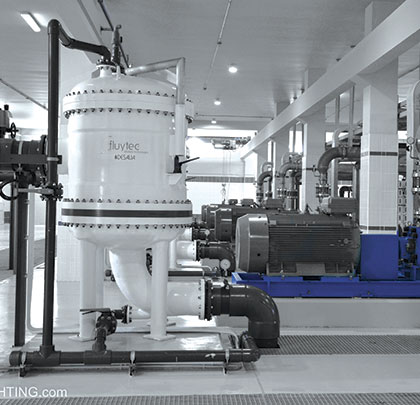Water is abundant on our planet: approximately two thirds of the earth’s surface is covered with it. Drinking and service water, however, is becoming increasingly scarce. The growing number of people (7.4 billion today and expected to rise up to 9.7 billion by 2050) contribute to this problem, as well as the fact that this growth is predominantly increasing in regions that have only limited access to fresh water (rivers, spring, and ground water).
Furthermore: In many urban areas in industrial countries, the supply of high quality drinking water is also becoming problematic. Nitrate pollution in the ground water and a lowering water table also mean that available resources can already no longer be used to their full extent.
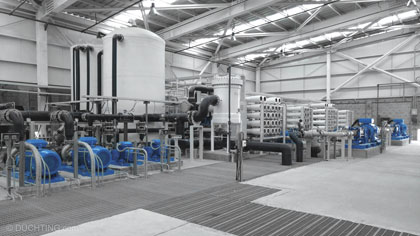
Featured Image: Pump type HPH & IP in Matrouh, Egypt, as high pressure feed pump in seawater desalination.
Above: Pump types HPH & IP in the system at Mejillones, Chile, for AES Gener.
SEAWATER DESALINATION SOLVES THE SUPPLY PROBLEM
This is why seawater desalination is attracting greater attention. Proven procedures are available—particularly reverse osmosis—which can be used as a continuous process on a large industrial scale. The core components of such systems include high-pressure pumps. It is their task to charge the membranes in the osmosis system with highly corrosive saltwater. The carrier fluid passes through the membrane, while the solids are held back and are eliminated.
Düchting dealt with this area of application in the early days as a manufacturer of high quality high-pressure pumps for challenging tasks and corrosive and/or abrasive media. The first pumps for seawater desalination systems were already planned and delivered at the beginning of the 1990s, working in accordance with the principle of reverse osmosis. The Düchting engineers used their experience and knowledge to optimise the corresponding pump series and also to develop new pump types for individual process steps within seawater desalination.

Pump type HPH in the multiphase desalination system at Kenya, Australia.
THE ENERGY EFFICIENCY CHALLENGE
The geographical focus of seawater desalination systems, installed to date, has been on the Arabic states. Water is scarce there, but low cost energy is available. This is indicative of a challenge that must be taken into account during system planning: seawater desalination is a proven, but also relatively energy intensive process. Pressures of up to 80 bars must be generated in order to develop the necessary osmotic pressure on the membrane.
Thus, the developer’s objective needs to be the use of drive and process components with high energy efficiency. This is valid for the individual components (i.e., the pumps and their drives) but also for the overall system. In this sector, Düchting has developed solutions that point the way forward.
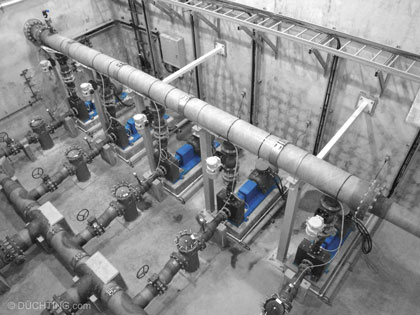
Pumps in the MC series as supply pumps in seawater desalination.
CORE COMPONENTS: HIGH-PRESSURE PUMPS
Düchting offers multistage high-pressure pumps in the series HPH and HPXU that are designed specifically for the requirements of seawater desalination. They achieve high pumping capacity of up to 925,000 gallons per hour at pressures of up to 100 bars.
Among other things, the correct selection of stainless steel materials with regard to seawater and wear resistance, leads to the high reliability of the pumps. Specially designed hydraulics guarantee optimum degrees of efficiency at the operating point and, thus, make an important contribution to energy efficiency in the overall system.
MINERAL CASTING AS IDEAL MATERIAL
Besides the high pressure pumps, which are used for feeding the reverse osmosis membranes various other pumps are also in use but work with lower pressure level and sometimes also transport smaller quantities of water. These include, for example, auxiliary pumps, feeding pumps, and backwash pumps to clean the membranes.
Here, the requirements that result from the pumping medium and the continuous operating method of the pumps are also high. However, the lower pressure level provides the opportunity not to use stainless steel as a material of construction, which is firstly expensive and secondly difficult to process.
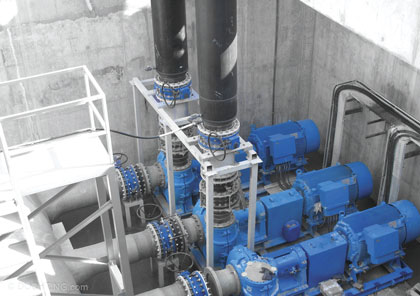
Pumps in the series MCC 400-520 II as intake pumps for seawater desalination.
SICCAST® AS AN ALTERNATIVE TO PLASTIC AND STAINLESS STEEL
Now, many system operators have had excellent experiences with Düchting pumps with a mineral cast casing and impeller. They are made of the material SICcast®, which is manufactured and processed by a company in the Düchting Group. It comprises of up to 80 percent silicon carbide and 20 percent special epoxy resin as a binding agent.
This material is free of metal, highly resistant to chemicals, anti-magnetic and its hardness is similar to diamonds. The wear to pump components made of SICcast® is correspondingly low, even in unfavourable conditions and with abrasive and corrosive media.
The chemical bonding of the epoxy resin makes the material ductile and, thus, impervious to temperature shock and impact. It also has noise and vibration dampening effects, which is a great advantage, particularly for pump components.
The temperature-controlled casting process achieves a very low level of shrinkage and correspondingly high size accuracy—an important prerequisite for the production of pump casings and impellers. This characteristics profile makes SICcast® an excellent alternative to plastic and stainless steel in pump construction, and the Düchting pump series in mineral casting—including the MC and MCC series and the vertical use MCV series—is used in many seawater desalination systems around the world.
All parts of these pumps that come into contact with water are manufactured in SICcast®. In general, Düchting offers pumps of this material with capacity of up to 3.9 million gallons per hour, in horizontal and vertical arrangements.
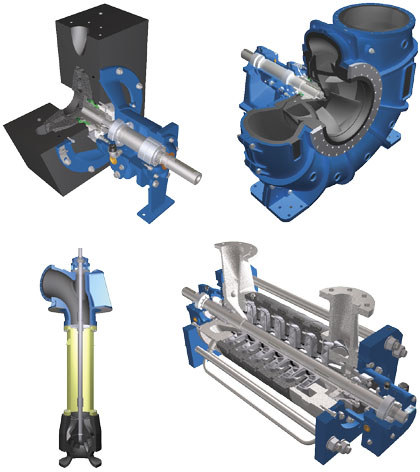
Above Left: A pump in the MC series in cross section.
Above Right: A pump in the MCC series in cross section.
Bottom Left: A pump in the MCV series in cross section.
Bottom Right: A pump in the HPH series in cross section.
OVERALL SOLUTIONS WITH ENERGY RECOVERY
A concentrate flow with high pressure is available at the end of the reverse osmosis process. This energy can be recovered in order to reduce the overall energy consumption of the desalination plant.
Pelton turbines are suitable for this task. The energy from the concentrate is again fed into the overall system, “downstream” through the direct coupling of the turbine shaft with the pump shaft. This lowers the drive power that is installed at the high-pressure pump. In practice up to 45 percent of the required drive power can be recovered this way and, thus, be saved. Düchting plans and supplies customized complete solutions with high-pressure pump, drive motor, and Pelton turbine for these package solutions. ◆
For More Information:
Gero Zies is technical director at Düchting Pumpen GmbH & Co. KG. Düchting has been developing and manufacturing pumps for seawater desalination systems for more than twenty years. Different pump designs are available for different tasks–in stainless steel and also in highly wear and corrosion resistant mineral casting. Düchting also designs complete system solutions incorporating energy recovery using a Pelton turbine. For more information, visit www.duechting.com.
____________________________________________
MODERN PUMPING TODAY, July 2016
Did you enjoy this article?
Subscribe to the FREE Digital Edition of Modern Pumping Today Magazine!
![]()


